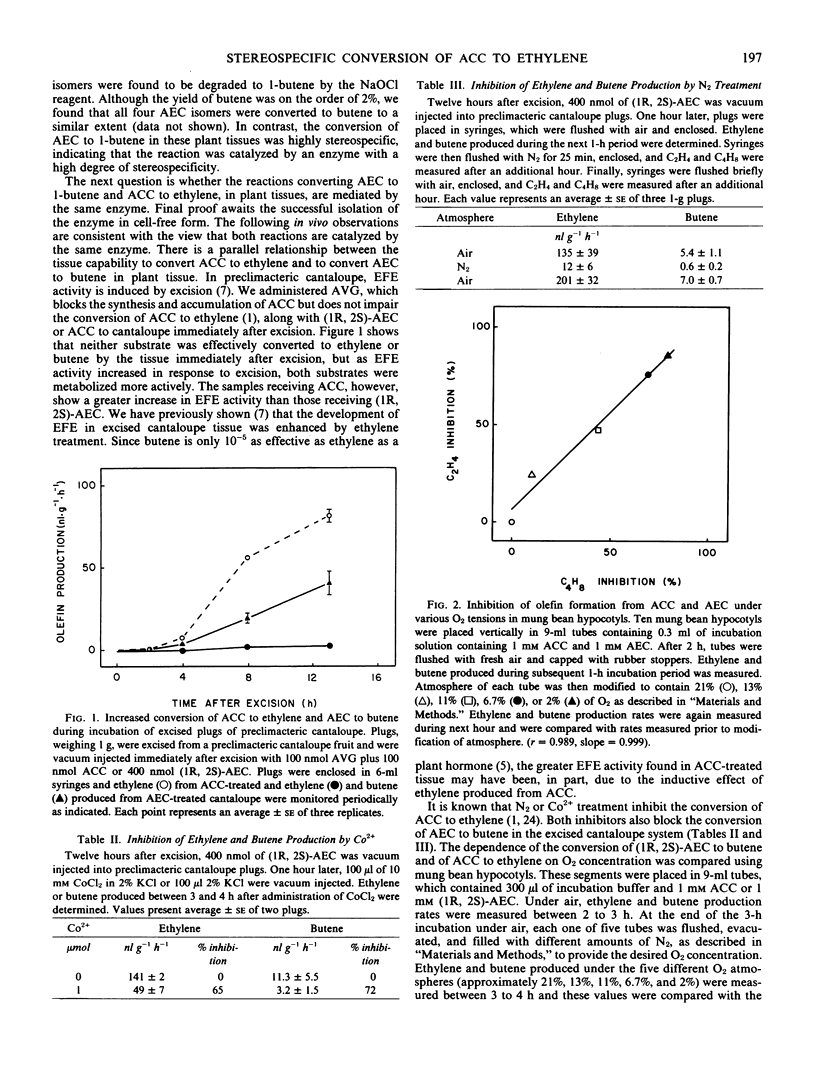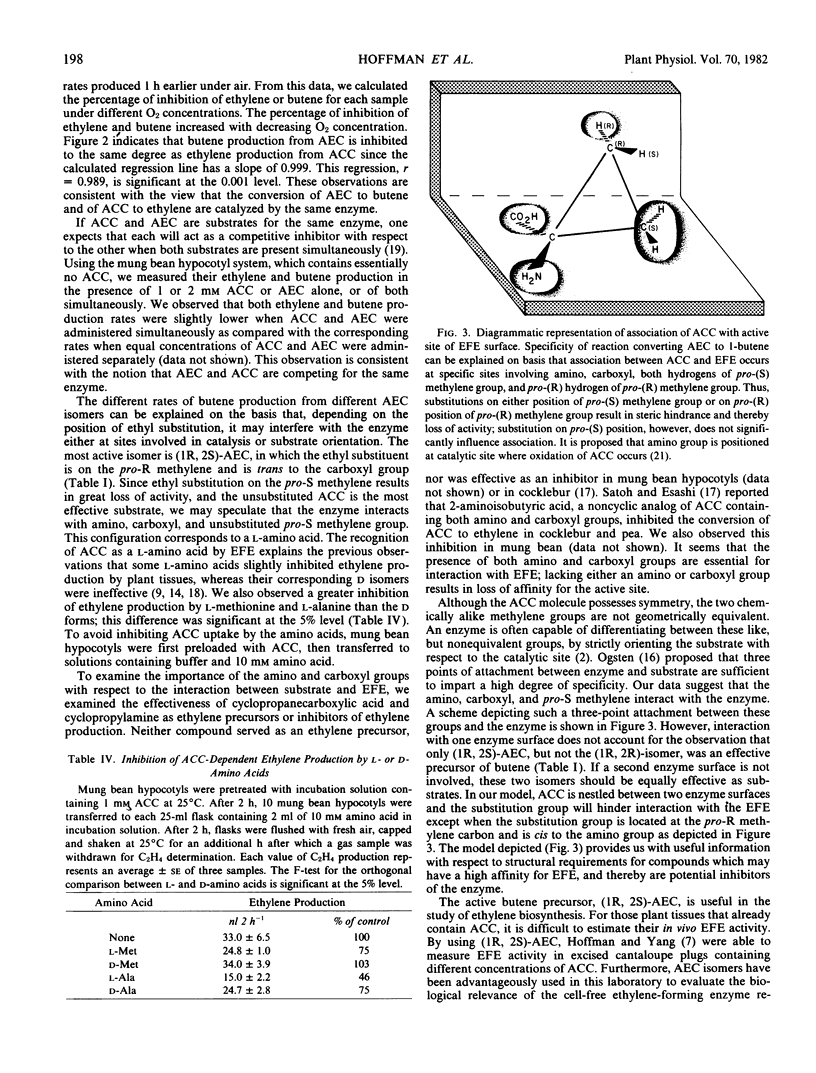Abstract
Inasmuch as the molecule of 1-aminocyclopropanecarboxylic acid (ACC) possesses reflective symmetry but lacks rotational symmetry, the two chemically alike methylene groups can be distinguished by a stereospecific enzyme. To determine whether ACC conversion to ethylene by plant tissues proceeds in a stereospecific fashion, the four stereoisomers of 1-amino-2-ethylcyclopropanecarboxylic acid (AEC) were administered to postclimacteric apple (Malus sylvestris Mill., var. Golden Delicious), excised preclimacteric cantaloupe (Cucumis melo L., var. reticulatis Naud cv. PMR-45), and etiolated mung bean (Vigna radiata L., Wilczek, var. Berken) hypocotyls. In each case (1R,2S)-AEC was the preferred substrate yielding 1-butene. In contrast, all AEC isomers were converted equally well to butene by chemical oxidation using NaOCl. Both ACC and AEC appear to be substrates for the same enzyme since both reactions are inhibited in parallel by N2 or Co2+, both reactions are induced in parallel by excision, and when both substrates are present simultaneously each will act as an inhibitor with respect to the other. The aforementioned observations indicate that ACC is stereospecifically converted to ethylene. For AEC to be the most active precursor of 1-butene, the ethyl substituent should be trans to the carboxyl group and the pro-(S) methylene group should be unsubstituted. This observation leads to the suggestion that the enzyme interacts with amino, carboxyl, and pro-(S) methylene groups, a configuration corresponding to a l-amino acid. This view is consistent with the observation that the l-forms of alanine and methionine inhibit the conversion of ACC to ethylene more than the corresponding d-amino acids in the mung bean hypocotyl system.
Full text
PDF




Selected References
These references are in PubMed. This may not be the complete list of references from this article.
- Adams D. O., Yang S. F. Ethylene biosynthesis: Identification of 1-aminocyclopropane-1-carboxylic acid as an intermediate in the conversion of methionine to ethylene. Proc Natl Acad Sci U S A. 1979 Jan;76(1):170–174. doi: 10.1073/pnas.76.1.170. [DOI] [PMC free article] [PubMed] [Google Scholar]
- Apelbaum A., Burgoon A. C., Anderson J. D., Solomos T., Lieberman M. Some Characteristics of the System Converting 1-Aminocyclopropane-1-carboxylic Acid to Ethylene. Plant Physiol. 1981 Jan;67(1):80–84. doi: 10.1104/pp.67.1.80. [DOI] [PMC free article] [PubMed] [Google Scholar]
- Hoffman N. E., Yang S. F. Enhancement of wound-induced ethylene synthesis by ethylene in preclimacteric cantaloupe. Plant Physiol. 1982 Feb;69(2):317–322. doi: 10.1104/pp.69.2.317. [DOI] [PMC free article] [PubMed] [Google Scholar]
- Hyodo H., Nishino T. Wound-induced Ethylene Formation in Albedo Tissue of Citrus Fruit. Plant Physiol. 1981 Mar;67(3):421–423. doi: 10.1104/pp.67.3.421. [DOI] [PMC free article] [PubMed] [Google Scholar]
- Lizada M. C., Yang S. F. A simple and sensitive assay for 1-aminocyclopropane-1-carboxylic acid. Anal Biochem. 1979 Nov 15;100(1):140–145. doi: 10.1016/0003-2697(79)90123-4. [DOI] [PubMed] [Google Scholar]
- Yu Y. B., Adams D. O., Yang S. F. 1-Aminocyclopropanecarboxylate synthase, a key enzyme in ethylene biosynthesis. Arch Biochem Biophys. 1979 Nov;198(1):280–286. doi: 10.1016/0003-9861(79)90420-x. [DOI] [PubMed] [Google Scholar]
- Yu Y. B., Adams D. O., Yang S. F. Inhibition of ethylene production by 2,4-dinitrophenol and high temperature. Plant Physiol. 1980 Aug;66(2):286–290. doi: 10.1104/pp.66.2.286. [DOI] [PMC free article] [PubMed] [Google Scholar]
- Yu Y. B., Yang S. F. Auxin-induced Ethylene Production and Its Inhibition by Aminoethyoxyvinylglycine and Cobalt Ion. Plant Physiol. 1979 Dec;64(6):1074–1077. doi: 10.1104/pp.64.6.1074. [DOI] [PMC free article] [PubMed] [Google Scholar]


